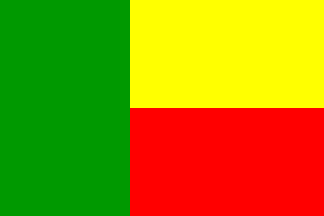
![[Benin flag construction sheet]](../images/b/bj'.gif)
![[National flag and ensign]](../misc/oooooo.gif) 2:3
image by Željko Heimer based on Album des Pavillons 2000 [pay00],
11 Jan 2001
2:3
image by Željko Heimer based on Album des Pavillons 2000 [pay00],
11 Jan 2001 
Last modified: 2025-07-26 by bruce berry
Keywords: benin | dahomey | africa | star | pan-african |
Links: FOTW homepage |
search |
disclaimer and copyright |
write us |
mirrors

![[National flag and ensign]](../misc/oooooo.gif) 2:3
image by Zoltan Horvath, 19 April 2024
2:3
image by Zoltan Horvath, 19 April 2024
See also:
Benin gained independence in 1960 as a Republic of Dahomey. Up to 1975 the flag was the same as the
current one. However, between 1975 and 1990 the country was known as the
People's Republic of Benin
(République populaire du Bénin and used a flag that was green with a red star in the canton. The
flag originally adopted at independence was re-introduced in 1990.
Jarig Bakker, 22 September 2000
The symbolism of the colours of the flag are explained in the national anthem, namely green recalls hope and revival, red the courage of ancestors and yellow is a reminder to preserve the country's wealth. The flag of August 1960 (adopted on 16 November 1959, but hoisted for the first time on 1 August 1960) was re-established during the National Conference of Active Forces of the Nation (19–28 February 1990).
Dorling-Kindersley Pocket Book explains the colours as being Pan-African. Pedersen [ped70g] associates red to the soil, yellow to the savannas and green to palm trees. Whitney Smith [smi80] agrees with Pedersen, except for the red symbolizing the blood of ancestors.
According to Album des Pavillons [pay00], the national flag is also used as the national ensign
When the country became the People's Republic of Benin,
a new flag was adopted. This was abandoned when a multi-party democracy
was established in 1991. Although the original flag used between 1959 and 1975 was re-adopted, the country
retained the name Benin introduced in 1975. This was the name of the ancient African empire centered in
that area.
Summary of contributions by:
Željko Heimer and John Andrew Lowe, 30 November 1995
Nick Artimovich, 5 June 1996
Ivan Sache, 23 April 2000

![[Benin flag construction sheet]](../images/b/bj'.gif)
![[National flag and ensign]](../misc/oooooo.gif) 2:3
image by Željko Heimer based on Album des Pavillons 2000 [pay00],
11 Jan 2001
2:3
image by Željko Heimer based on Album des Pavillons 2000 [pay00],
11 Jan 2001
In the construction sheet is given in Album des Pavillons 2000 [pay00],
the
ratio between the length of the green field to the fly is 6:9, while ratio of yellow and red stripes is 5:5. In many sources
an erroneous flag image is shown where green stripe is of equal width as the yellow and red stripes.
Željko Heimer, 11 January 2001
This construction is based on the Constitution, see Flag in the
Constitution and the Anthem.
Colour Shades
The government website is
not so helpful concerning the colours, there is only description and symbolism of the flag. There is a
legislation document from 1990, when the flag of Dahomey
was restored as national flag of Benin, but it describes the flag only.
Other sources for colors:
Zoltan Horvath, 19 April 2024
Vertical Variant
While above mentioned sources depict the vertical variant of the flag in not the proper way, I created
a vertical flag image. It turns 90 degrees mirror-inverted, as seen on this photo.
Zoltan Horvath, 19 April 2024
The Coat of Arms were originally adopted in 1964 and were re-adopted in 1990 after being replaced in 1975 when the country became the People's Republic of Benin.
The Arms are surmounted by the national crest which consists of two horns with corn in the ear and filled with sand. These are reputed to stand for prosperity. Below is the national shield which is quartered and depicts a local Somba fortress in the top left quadrant representing the history of the country; in the top right quadrant is the Order of the Star of Benin, the highest decoration in the country. The bottom left quadrant features a palm tree and in the bottom right is a sailing ship representing the arrival of the Europeans. The shield is supported by a pair of leopards, the national animal of Benin.
Below the shield is the national motto (in French) Fraternite, Justice, Travail (Fraternity, Justice, Work).
Jarig Bakker, 22 September 2000
The image I created is based on a
Government website illustration.
Zoltan Horvath, 19 April 2024
![[Flag of Benin]](../images/b/bj!1965.jpg) image by BlinxCat
image by BlinxCat
This chart depicts the flag of
Dahomey (Benin) as more square-like, similar to how Switzerland is. I cannot find any further information on this
ratio.
BlinxCat, 16 June 2024